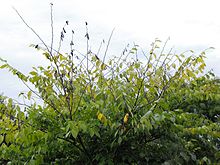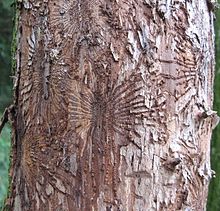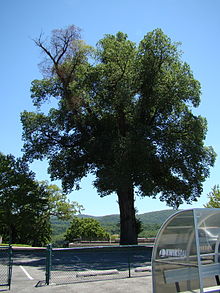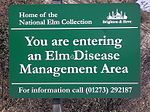- Dutch elm disease
-
Dutch elm disease (DED) is a disease caused by a member of the sac fungi category, affecting elm trees which is spread by the elm bark beetle. Although believed to be originally native to Asia, the disease has been accidentally introduced into America and Europe, where it has devastated native populations of elms which had not had the opportunity to evolve resistance to the disease. The name Dutch elm disease refers to its identification in the Netherlands by a Dutch phytopathologist in 1921; the disease is not specific to the Dutch elm hybrid.[1][2]
Contents
Overview
The causative agents of DED are ascomycete microfungi. Three species are now recognized: Ophiostoma ulmi, which afflicted Europe from 1910, reaching North America on imported timber in 1928, Ophiostoma himal-ulmi,[3] a species endemic to the western Himalaya, and the extremely virulent species, Ophiostoma novo-ulmi, which was first described in Europe and North America in the 1940s and has devastated elms in both areas since the late 1960s.[4] The origin of O. novo-ulmi remains unknown, but the species may have arisen as a hybrid between O. ulmi and O. himal-ulmi.[5] The new species was widely believed to have originated in China, but a comprehensive survey there in 1986 found no trace of it, although elm bark beetles were very common.[5]
The disease is spread in North America by three species of bark beetles (Family: Curculionidae, Subfamily: Scolytinae): the native elm bark beetle, Hylurgopinus rufipes, the European elm bark beetle, Scolytus multistriatus, and the banded elm bark beetle, Scolytus schevyrewi. In Europe, while the aforementioned Scolytus multistriatus again acts as vector for infection, it is much less effective than the large elm bark beetle Scolytus scolytus. The native elm bark beetle can be a vector for the disease, but is inefficient compared to the other vectors. Scolytus schevyrewi was found in 2003 in Colorado and Utah, and is now in 10 western states.
Mechanism
In an attempt to block the fungus from spreading farther, the tree reacts by plugging its own xylem tissue with gum and tyloses, bladder-like extensions of the xylem cell wall. As the xylem (one of the two types of vascular tissue produced by the vascular cambium, the other being the phloem) delivers water and nutrients to the rest of the plant, these plugs prevent them from travelling up the trunk of the tree, eventually killing it. (Xylem comprises the bulk of the hard tissue of the interior of trunks and branches of woody plants and is nearly synonymous with "wood". Phloem can be thought of as a thin sheet of tissue wrapped around the central cylinder of xylem, although just beneath the phloem is another thin sheet, the vascular cambium, which produces both phloem and xylem. The bark is external to the phloem.)
Symptoms
The first symptom of infection is usually an upper branch of the tree with leaves starting to wither and yellow in summer, months before the normal autumnal leaf shedding. This progressively spreads to the rest of the tree, with further dieback of branches. Eventually, the roots die, starved of nutrients from the leaves. Often, not all the roots die: the roots of some species, notably the English elm Ulmus procera, put up suckers which flourish for approximately 15 years, after which they too succumb.[4]
Disease range
Europe
Dutch elm disease was first noticed in Europe in 1910, and spread slowly, reaching Britain in 1927. This first strain was a relatively mild one, which killed only a small proportion of elms, more often just killing a few branches, and had largely died out by 1940 owing to its susceptibility to viruses. The disease was isolated in The Netherlands in 1921 by Bea Schwarz, a pioneering Dutch phytopathologist, and this discovery would lend the disease its name.[6]
Circa 1967, a new, far more virulent strain arrived in Britain on a shipment of rock elm U. thomasii logs from North America, and this strain proved both highly contagious and lethal to European elms; more than 25 million trees have died in the UK alone. The disease is still migrating northwards through Scotland, reaching Edinburgh in the late 1970s, and Inverness in 2006. By 1990, very few mature elms were left in Britain or much of continental Europe. One of the most distinctive English countryside trees, the English elm U. procera Salisb. (see John Constable's painting Salisbury Cathedral from the South-West), is particularly susceptible. Thirty years after the outbreak of the epidemic, nearly all these trees, which often grew to more than 45 m high, are gone. The species still survives in hedgerows, as the roots are not killed and send up root sprouts ("suckers"). These suckers rarely reach more than 5 m tall before succumbing to a new attack of the fungus. However, established hedges kept low by clipping have remained apparently healthy throughout the nearly 40 years since the onset of the disease in the UK.
The largest concentrations of mature elms in Europe are now in Amsterdam and The Hague. In 2005, Amsterdam was declared the 'Elm City of Europe': the city’s streets and canals are lined with at least 75,000 elms, including several generations of research-elms (see below: Resistant trees).[7][8] Some 30,000 of the 100,000 mature trees in The Hague are elms, planted because of their tolerance of salty sea-winds. Since the 1990s, a programme of antifungal injections of the most prominent 10,000 elms, and of sanitation felling, has reduced annual elm losses in The Hague from 7% to less than 1% (see below: Preventive treatment). The losses are made up by the planting of disease-resistant cultivars.[9] The largest concentration of mature elm trees remaining in England is in Brighton and Hove, East Sussex, where 15,000 elms still stand (2005 figures), several of which are estimated to be over 400 years old. Their survival is owing to the isolation of the area, between the English Channel and the South Downs, and the assiduous efforts of local authorities to identify and remove infected sections of trees immediately when they show symptoms of the disease.[10] Empowered by the Dutch Elm Disease (Local Authorities) (Amendment) Order 1988,[11] local authorities may order the destruction of any infected trees or timber, although in practice they usually do it themselves, successfully reducing the numbers of elm bark beetle Scolytus spp., the vector of elm disease.[12] The largest concentration of mature elms in Scotland is in Edinburgh, where 5000 elms still stand (2009 figures) out of some 35,000 in 1976. A policy of sanitary felling has kept losses to an average of 1000 a year.[13] Elm was the commonest tree in Paris from the 17th century; before the 1970s there were some 30,000 ormes parisiens. Today, only 1000 mature elms survive in the city, including examples in the large avenues (Avenue d'Italie, Avenue de Choisy, Boulevard Lefebvre, Boulevard de Grenelle, Boulevard Garibaldi) and two very old specimens, one in the garden of the Tuileries in front of the l'Orangerie and another in the Place Saint-Gervais in front of l'hôtel de ville de Paris. Losses are now being made up with disease-resistant cultivars, especially the Dutch-French research elm 'Nanguen' (Lutèce), named after the city.[14] [15]
North America
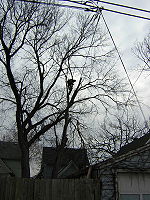 Certified arborist removing infected elm in Saint Paul, Minnesota
Certified arborist removing infected elm in Saint Paul, Minnesota
The disease was first reported in the United States in 1928, with the beetles believed to have arrived in a shipment of logs from The Netherlands destined for use as veneer in the Ohio furniture industry. The disease spread slowly from New England westward and southward, almost completely destroying the famous elms in the 'Elm City' of New Haven, reaching the Detroit area in 1950,[16] the Chicago area by 1960, and Minneapolis by 1970.
Dutch elm disease reached eastern Canada during the Second World War, and spread to Ontario in 1967, Manitoba in 1975 and Saskatchewan in 1981. In Toronto, 80% of the elm trees have been lost to Dutch elm disease; many more fell victim in Ottawa, Montreal and other cities during the 1970s and 1980s. Quebec City still has about 21,000 elms, thanks to a prevention program initiated in 1981.[17] Alberta and British Columbia are the only provinces that are currently free of Dutch elm disease, although, in an isolated case, an elm tree in southeastern Alberta found diseased in 1998 was immediately destroyed. Today, Alberta has the largest number of elms unaffected by Dutch elm disease in the world[citation needed]; many streets and parks in Edmonton and Calgary are still lined with healthy, mature trees. Aggressive measures are being taken to prevent the spread of the disease into Alberta, as well as other parts of Canada. The City of Edmonton has banned elm pruning from March 31 to October 1, since fresh pruning wounds will attract the beetles during the warmer months.
The largest surviving urban forest of elm trees in North America is believed to be in the city of Winnipeg, Manitoba, where close to 200,000 elms remain - at least double that of Amsterdam, the "Elm City of Europe". The city of Winnipeg spends $3M annually to aggressively combat the disease using Dursban Turf[18] and the Dutch Trig vaccine,[19] losing 1500-4000 trees per year.
Australia
Owing to its geographical isolation and effective quarantine enforcement, Australia has so far been unaffected by Dutch elm disease, retaining its many stands of introduced elm varieties.
Preventive Treatment
Chemical
The first fungicide used for preventive treatment of Dutch elm disease was Lignasan BLP (carbendazim phosphate), which was introduced in the 1970s. This had to be injected into the base of the tree using specialized equipment, and was never especially effective. It is still sold under the name "Elm Fungicide". Arbotect (thiabendazole hypophosphite) became available some years later, and it has been proven effective. Arbotect must be injected every two to three years to provide ongoing control; the disease generally cannot be eradicated once a tree is infected. There is a process called tracing that was invented by Rainbow Treecare in Minneapolis. It has proven to be effective at saving infected elms as long as the Dutch elm disease fungus has not grown into the roots.
Arbotect is not effective on root graft infections from adjacent elm trees. It is more than 99.5% effective for three years from beetle infections, which is the primary mode of tree infection.
Alamo (propiconazole) has become available more recently, though several university studies show it to be effective for only the current season it is injected. Alamo is primarily recommended for treatment of oak wilt.
Biological
Because of the ban on the use of chemicals on street and park trees in the Netherlands, the University of Amsterdam developed a biological vaccine by the late 1980s. Dutch Trig is nonchemical and nontoxic, consisting of a suspension in distilled water of spores of a strain of the fungus Verticillium albo-atrum that has lost much of its pathogenic capabilities, injected in the elm in spring. The strain is believed to have enough pathogenicity left to induce an immune response in the elm, protecting it against DED during one growing season. This is called induced resistance.[20]
Preventive treatment is costly, and at best will prolong the life of the tree by perhaps five or ten years. It is usually only justified when a tree has unusual symbolic value or occupies a particularly important place in the landscape. The injections have no curative properties on trees which already have Dutch elm disease.
Practical information for elm tree owners
DED is caused by a fungus. It is primarily spread in three ways:
- By beetle vectors which carry the fungus from tree to tree — the beetle does not kill the tree, the fungus it carries does.
- Through connection of an infected tree's roots with a neighboring healthy tree.
- By pruning of a healthy tree with saws which have been used to take down diseased trees. This third method of spread is common and not recognized by many tree pruning and removal services. Arborists at Kansas State University claim that cleaning blades with a 10% solution of a household bleach will prevent this type of spread. Owners of healthy trees should be vigilant about the companies they hire to prune healthy trees. Blades need to be disinfected between use to remove dead trees and use to prune healthy trees.
Resistant trees
Research to select resistant cultivars and varieties began in the Netherlands in 1928, followed by the USA in 1937. Initial efforts in the Netherlands involved crossing varieties of U. minor and U. glabra, but later included the Himalayan or Kashmir elm U. wallichiana as a source of antifungal genes. Early efforts in the USA involved the hybridization of the Siberian elm U. pumila with American red elm U. rubra to produce resistant trees. Resulting cultivars lacked the traditional shape and landscape value of the American elm; few were planted.
In 2005, the National Elm Trial (USA) began a 10-year evaluation of 19 cultivars in plantings across the United States. The trees in the trial are exclusively American developments; no European cultivars have been included.
Recent research in Sweden has established that early-flushing clones are less susceptible to DED owing to an asynchrony between DED susceptibility and infection.[21]
Hybrid cultivars
Many attempts to breed disease resistant cultivar hybrids have usually involved a genetic contribution from Asian elm species which have demonstrable resistance to this fungal disease. Much of the early work was undertaken in the Netherlands. The Dutch research programme began in 1928, and ended after 64 years in 1992, during which time well over 1000 cultivars were raised and evaluated. The programme had three major successes: 'Columella', 'Nanguen' LUTÈCE, and 'Wanoux' VADA,[22] all found to have an extremely high resistance to the disease when inoculated with unnaturally large doses of the fungus. Only 'Columella' was released during the lifetime of the Dutch programme, in 1987; patents for the LUTÈCE and VADA clones were purchased by the French Institut National de la Recherche Agronomique (INRA), which subjected the trees to 20 years of field trials in the Bois de Vincennes, Paris, before releasing them to commerce in 2002 and 2006, respectively.
Asian species to feature in the American DED research programs were the Siberian elm U. pumila, Japanese elm U. davidiana var. japonica, and the Chinese elm U. parvifolia, giving rise to several dozen hybrid cultivars resistant not just to DED, but also to the extreme cold of Asian winters. Among the most widely planted of these, both in North America and in Europe, are 'Sapporo Autumn Gold' and 'New Horizon'. Some hybrid cultivars, such as 'Regal', are the product of both Dutch and American research. Hybridization experiments using the slippery or red elm U. rubra resulted in the release of 'Coolshade' and 'Rosehill' in the 1940s and 50s. The species last featured in hybridization as the female parent of 'Repura' and 'Revera', both patented in 1993, although neither has yet appeared in commerce.
In Italy, research is continuing at the Istituto per la Protezione delle Piante, Florence, to produce a range of disease-resistant trees adapted to the warmer Mediterranean climate, using a variety of Asiatic species crossed with the early Dutch hybrid 'Plantyn' as a safeguard against any future mutation of the disease.[23] Two trees with very high levels of resistance, 'San Zanobi' and 'Plinio',[24] were released in 2003. 'Arno' and 'Fiorente' were patented in 2006 and will enter commerce in 2012. All four have the Siberian elm U. pumila as a parent, the source of disease-resistance and drought-tolerance genes. Further releases are planned, notably of a clone derived from a crossing of Dutch elm Ulmus × hollandica with the Chinese species U. chenmoui.
Species and species cultivars
North America
Ten resistant American elm U. americana cultivars are now in commerce in North America, but only two ('Princeton' and 'Valley Forge') are currently available in Europe. No cultivar is "immune" to DED; even highly resistant cultivars can become infected, particularly if already stressed by drought or other environmental conditions where the disease prevalence is high. With the exception of 'Princeton', no trees have yet been grown to maturity. Trees cannot be said to be mature until they have reached an age of 60 years.
Notable cultivars include:
- 'Princeton', is a cultivar selected in 1922 by Princeton Nurseries for its landscape merit. By happy coincidence, this cultivar was found to be highly resistant in inoculation studies carried out by the USDA in the early 1990s. As trees planted in the 1920s still survive, the properties of the mature plant are well known.
- 'American Liberty', is, in fact, a set of six cultivars of moderate to high resistance produced through selection over several generations starting in the 1970s. Although 'American Liberty' is marketed as a single variety, nurseries selling the "Liberty Elm" actually distribute the six cultivars at random and thus, unfortunately, the resistance of any particular tree cannot be known. One of the cultivars, 'Independence', is covered by patent (U. S. Plant patent 6227). The oldest 'American Liberty' elm was planted in about 1980.
- 'Valley Forge', released in 1995, has demonstrated the highest resistance of all the clones to Dutch elm disease in controlled USDA tests.
- 'Lewis and Clark' (Prairie Expedition TM ), released in 2004, was cloned from a tree found growing in North Dakota which had survived unscathed when all around had succumbed to disease.
In 2007, the Elm Recovery Project from the University of Guelph in Ontario, Canada reported that cuttings from healthy surviving old elms surveyed across Ontario had been grown to produce a bank of resistant trees, isolated for selective breeding of highly resistant cultivars [12] .
The University of Minnesota USA is testing various elms, including a huge now-patented century-old survivor known as "The St. Croix Elm", which is located in a Minneapolis-St. Paul, MN suburb (Afton) in the St. Croix River valley — a designated National Scenic Riverway.
The slippery or red elm U. rubra is marginally less susceptible to Dutch elm disease than the other American species, but this quality seems to have been largely ignored in American research. No cultivars were ever selected, although the tree was used in hybridization experiments (see above).
Europe
Among European species, there is the unique example of the European white elm U. laevis, which has little innate resistance to DED, but is eschewed by the vector bark beetles and only rarely becomes infected. Recent research has indicated it is the presence of certain organic compounds, such as triterpenes and sterols, which serves to make the tree bark unattractive to the beetle species that spread the disease.[25]
In 2001, English elm U. procera was genetically engineered to resist disease, in experiments at Abertay University, Dundee, Scotland, by transferring antifungal genes into the elm genome using minute DNA-coated ball bearings.[26] However, owing to the hostility to GM developments, there are no plans to release the trees into the countryside.
The spread of DED to Scotland has revealed a number of Wych elms U. glabra apparently surviving there unscathed, prompting the Royal Botanic Garden Edinburgh to clone the trees and inoculate them with the fungus to determine any innate resistance (2010).[27]
Possible earlier occurrences
The 'Elm Decline'
From analysis of fossil pollen in peat samples, it is apparent that elms, an abundant tree in prehistoric times, all but disappeared from northwestern Europe during the mid-Holocene period about 6000 years ago, and to a lesser extent 3000 years ago. This roughly synchronous and widespread event has come to be known as the 'Elm Decline'. When first detected in the mid-20th century, the decline was attributed to the impact of forest-clearance by Neolithic farmers, and of elm-coppicing for animal fodder, though the numbers of settlers could not have been large. The devastation caused recently by DED has provided an alternative explanation. Examination of subfossil elm wood showing signs of the changes associated with the disease has suggested that a form of DED "may" have been responsible. Fossil finds from this period of elm bark beetles support this theory. A consensus of opinion today is that the Elm Decline was probably driven by both factors.[28] [13]
Historic period
A less devastating form of the disease, caused by a different fungus, had possibly been present in Britain for some time, as this passage in Richard Jefferies' 1883 book, Nature near London, shows:
- There is something wrong with elm trees. In the early part of this summer, not long after the leaves were fairly out upon them, here and there a branch appeared as if it had been touched with red-hot iron and burnt up, all the leaves withered and browned on the boughs. First one tree was thus affected, then another, then a third, till, looking round the fields, it seemed as if every fourth or fifth tree had thus been burnt. [...] Upon mentioning this I found that it had been noticed in elm avenues and groups a hundred miles distant, so that it is not a local circumstance.
Though dead elms also appear in Italian paintings of the late 15th century, this suggestion remains largely speculative, and there is no proof that it was caused by a fungus related to Dutch elm disease.
References
- ^ Forestry Commission. Dutch elm disease in Britain [1], UK.
- ^ Macmillan Science Library: Plant Sciences. Dutch Elm Disease
- ^ Brasier, C. M. & Mehotra, M. D. (1995). Ophiostoma himal-ulmi sp. nov., a new species of Dutch elm disease fungus endemic to the Himalayas. Mycological Research 1995, vol. 99 (2), pp. 205-215 (44 ref.) ISSN 0953-7562. Elsevier, Oxford, UK.
- ^ a b Spooner B. and Roberts P. 2005. Fungi. Collins New Naturalist series No. 96. HarperCollins Publishers, London
- ^ a b Brasier, C. M. (1996). New horizons in Dutch elm disease control. Pages 20-28 in: Report on Forest Research, 1996. Forestry Commission. HMSO, London, UK.[7]
- ^ [2]
- ^ DutchAmsterdamnl website, dutchamsterdam.nl/127-amsterdam-trees
- ^ Amsterdamse Bomem
- ^ DutchTrig® website: dutchtrig.com/the_netherlands/the_hague.html
- ^ Brighton and Hove Council page on the city's elm collection (viewed 2 June 2010)
- ^ [3]
- ^ [4]
- ^ Coleman, Max, ed.: Wych Elm (Edinburgh, 2009; ISBN 978-1-906129-21-7), p.47
- ^ Ulmus 'Nanguen' (Lutèce®), www.international.inra.fr [5]
- ^ Ulmus 'Nanguen' (Lutèce®)], www.foretpriveefrancaise.com [6]
- ^ [7]
- ^ Contact, Laval University, Volume 28, Number 1
- ^ City of Winnipeg Elm Bark Beetle Control Program
- ^ "Dutch Elm Vaccine Tested In Winnipeg"
- ^ About Dutch Trig®
- ^ Ghelardini, L. (2007) Bud Burst Phenology, Dormancy Release & Susceptibility to Dutch Elm Disease in Elms (Ulmus spp.). Doctoral Thesis No. 2007:134. Faculty of natural Resources and Agricultural Services, Swedish University of Agricultural Sciences, Uppsala, Sweden
- ^ Institut National de la Recherche Agronomique. Lutèce, a resistant variety, brings elms back to Paris [8], Paris, France
- ^ Santini A., Fagnani A., Ferrini F., Mittempergher L., Brunetti M., Crivellaro A., Macchioni N., Elm breeding for DED resistance, the Italian clones and their wood properties. Invest Agrar: Sist Recur For (2004) 13 (1), 179-184. 2004. [9]
- ^ Santini A., Fagnani A., Ferrini F. & Mittempergher L., (2002) San Zanobi and Plinio elm trees. HortScience 37(7): 1139-1141. 2002. American Society for Horticultural Science, Alexandria, VA 22314, USA.
- ^ Martín-Benito D., Concepción García-Vallejo M., Alberto Pajares J., López D. 2005. Triterpenes in elms in Spain. Can. J. For. Res. 35: 199–205 (2005). [10]
- ^ 'First Genetically Modified Dutch Elm Trees Grown', unisci.com [11]
- ^ Coleman, Max, ed.: Wych Elm (Royal Botanic Gardens Edinburgh, 2009; ISBN 978-1-906129-21-7). A study of the species, with particular reference to the Wych elm in Scotland
- ^ Coleman, Max, ed.: Wych Elm (Edinburgh, 2009; ISBN 978-1-906129-21-7), p.17
External links
- Walter E. Burton "Army of Experts Wage War on Dutch Elm Disease" Popular Science Monthly, May 1937
- Elm Recovery Project - Guelph University (Canada)
- Dutch elm disease - info from the Government of Alberta
- Dutch elm disease - info from the Government of British Columbia
- DED info from Rainbow Treecare Scientific Advancements
- The Mid-Holocene Ulmus decline: a new way to evaluate the pathogen hypothesis
- Dutch Elm Disease - Gallery of Pests
- KIM PALMER, Minneapolis, Minnesota USA Star Tribune
- Species Profile- Dutch Elm Disease (Ophiostoma ulmi and Ophiostoma novo-ulmi), National Invasive Species Information Center, United States National Agricultural Library. Lists general information and resources for Dutch Elm Disease.
Categories:- Tree diseases
- Sordariomycetes
- Natural history of the United States
- Invasive fungus species
Wikimedia Foundation. 2010.

